Cooperation and Reciprocal Altruism
I. If we define cooperation as occurring when a recipient's fitness increases
but the donor's fitness either doesn't change, or also increases, how can cooperation
evolve? Four alternatives are recognized:
A. Mutualism: both parties benefit immediately. For example, group hunting by
wild dogs
B. Kin Selection: preferentially give aid to relatives. Many examples including some
cases of cooperative breeding, eusociality in haplo-diploid organisms
C. By-product mutualism: as a consequence of behaving selfishly, the donor inadvertantly
benefits the recipient. The benefit sometimes may not occur instantaneously, as in
mutualism. This mechanism may be quite common. One example is cleaner fish (wrasse)
consume ectoparasites of larger fish without risk of predation. In this case the
large fish performs a beneficient act by not consuming the cleaner fish. The benefit
is returned because the cleaner selfishly consumes ectoparasites, but the cleaner
pays no cost for its behavior and is, in fact, acting in its own self-interest. This
has also been referred to as pseudo-reciprocity.
D. Reciprocal altruism: the trading of altruistic acts in which benefit is larger
than cost so that over a period of time both participants enjoy a net gain.
1. Delay between receipt of benefit and cost donation separates mutualism from reciprocal
altruism.
2. Delay allows for the possibility of cheating, thus cheaters must be detectable
and excluded
3. Sufficient numbers of interactions must occur to provide net benefit to participants.
Note that in many instances, net benefit will increase with number of reciprocal
exchanges received in a lifetime. Thus, a large number of interactions can favor
reciprocity.
II. How can reciprocity increase when initially rare?
A. Occur in kin groups and be facilitated by kin selection
B. Be directed preferentially to reciprocators
III. TIT FOR TAT as a model of reciprocity
A. Based on the Prisoner's Dilemma game: two suspected criminals are jailed separately
and encouraged to provide evidence that the other was involved in the crime.
1. The payoff matrix for one iteration of this game is
Individual 2 responses:
cooperate
defect
Individual 1 actions: cooperate R=3 S=1
defect T=4 P=2
2. To be a PD, T > R > P > S and R > (T + S) / 2
3. Always defect is best strategy in a finite round game
B. Iterating this game allows for cheating - the key distinction between mutualism
and
reciprocity
1. Iteration permits complicated strategies, e.g. CDCDCCCD, etc.
2. TFT (cooperate on the first move and thereafter mimic your opponent) is the best
strategy because
a. Outscored all other strategies in computer tournament (Axelrod)
b. Is an ESS if the probability of future encounter, w, meets these criteria:
w > (T - R)/(T - P) and w > (T - R)/(R - S) (Axelrod & Hamilton)
Obtain these inequalities by applying 1, w, w2, w3,... to successive future payoffs
and noting that w + w2 + w3 +... = 1/(1 - w)
C. Once TFT evolves, can other strategies invade? Subsequent work indicates that
other trajectories may occur, e.g. TFT->Generous TFT->Pavlov->cooperation
(Nowak & Sigmund)
1. If mistakes are made, Generous-tit-for-tat does better than TFT (GTFT cooperates
after opponent cooperates but also after opponent defects with some probability)
2. Pavlov - win-stay, lose-shift does better than TFT because it corrects occasional
mistakes and exploits unconditional cooperators.
IV. Probable examples of reciprocity
A. Food sharing
1. Female vampire bats regurgitate blood to roost mates that fail to feed. Related
and unrelated females live together for many years, experiments in captivity show
that they reciprocate feedings with unrelated bats, and that the cost of a blood
meal is less than the benefit (Wilkinson)
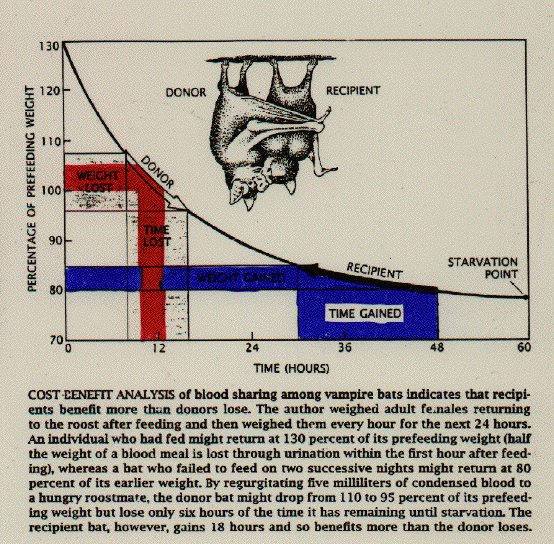
2. Chimpanzees in captivity share food reciprocally (Frans de Waal). Recent data
indicates that females tend to be unrelated or distantly related to each other.
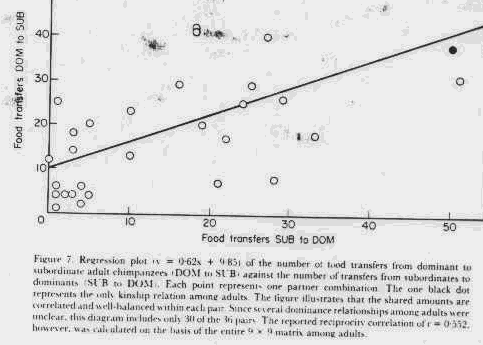
B. Alliance formation
1. baboons (Packer, Cheney, Noe)
2. vervet monkeys (Seyfarth & Cheney)
3. bottlenose dolphins (Connor)
C. Egg-trading in fish (Fischer) and polychaete worms (Sella)

D. Predator inspection in fish? (Milinski, Dugatkin)
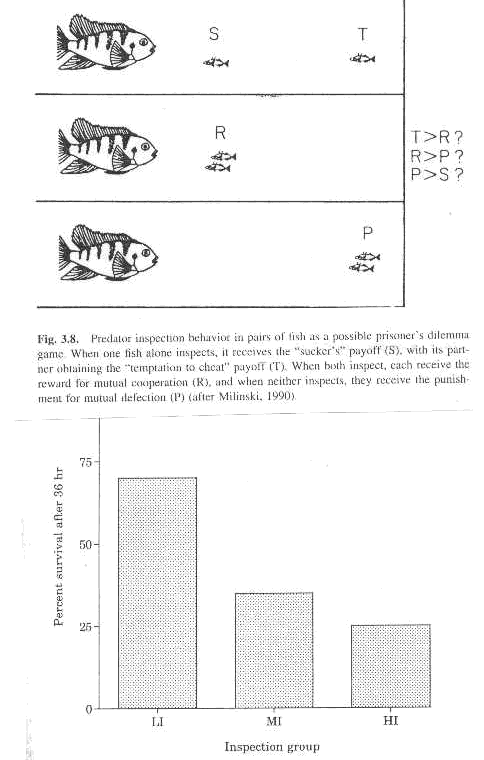


1. Milinski and Dugatkin used a mirror to simulate a cooperating partner (parallel
mirror) or a defecting partner (oblique mirror) fish.
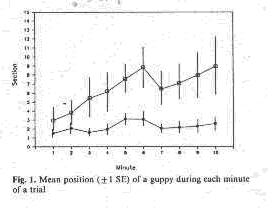

2. The fish with the parallel mirror approached the predator more closely, as
expected if TFT operates. But, Masters and Waite showed that the same outcome occurs
in the absence of a predator implying that the response is due to a schooling tendency
of the fish, not cooperative predator inspection.
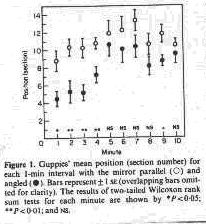
E. Dear neighbors - territorial birds often do not defend borders from neighbors
as aggressively as they will from foreigners as judged by playback studies
1. tree swallows
2. hooded warblers
F. Social grooming in antelope

V. Potential implications for human behaviors
A. Friendship formation, non-kin directed altruism, gift exchange ceremonies
B. Emotion evolution: gratitude, guilt and reparative altruism
C. Justice, moralistic aggression, and revenge
D. Reciprocal network size: cartel formation, dialects
References
Aoki, K. 1985 Reciprocal altruism and reciprocal alliance between relatives.
In: Population Genetics and Molecular Evolution (T. Ohta and K. Aoki, eds.) Springer-Verlag,
Berlin, pp. 429-441.
Axelrod, R. 1984 The Evolution of Cooperation. Basic Books, New York.
Axelrod, R. & Hamilton, W. D. 1981 The evolution of cooperation. Science 211:1390-1396.
Boorman, S. A. & Levitt, P. R. 1980 The Genetics of Altruism. Academic
Press, New York.
Boyd, R. 1989 Mistakes allow evolutionary stability in the repeated Prisoner's dilemma
game. J. Theor. Biol. 136:47-56.
Boyd, R., Lorberbaum, J. 1987 No pure strategy is evolutionarily stable in the repeated
Prisoner's Dilemma game. Nature 327:58-59.
Boyd, R. and P.J. Richerson 1988 The evolution of reciprocity in sizable groups.
J. Theor. Biol. 132:337-356.
Cheney, D. L. 1977 The acquisition of rank and the development of reciprocal alliances
among free ranging immature baboons. Behav. Ecol. Sociobiol. 2:303-318.
Clements, K.C. & D.W. Stephens 1995 Testing models of non-kin cooperation: mutualism
and the prisoner's dilemma. Anim. Behav. 50:527-535.
Connor, R. C., R. A. Smolker, & A.F. Richards 1992 Two levels of alliance formation
among male bottlenose dolphins (Tursiops sp.). Proc Natl. Acad. Sci. 89:987-990.
Dugatkin, L.A. 1990 N-person games and the evolution of cooperation: a model based
on predator inspection in fish. J. Theor. Biol. 142:123-135.
Dugatkin, L.A. 1991 Do guppies play TIT FOR TAT during predator inspection visits?
Behav. Ecol. Sociobiol. 25:395-399.
Dugatkin, L.A. 1997 Cooperation Among Animals: A Modern Perspective. Oxford University
Press, Oxford.
Eshel, I. & Cavalli-Sforza, L. C. 1982 Assortment of encounters and evolution
of cooperativeness. Proc. Natl. Acad. Sci. U.S.A. 79:1331-1335.
Ferriere, R. and R. E. Michod 1995 Invading wave of cooperation in a spatial iterated
prisoner's dilemma. Proc. R. Soc. Lond 259:77-83.
Fischer, E. 1980 The relationship between mating system and simultaneous hermaphroditism
in the coral reef fish, Hypoplectrus nigricans (Serranidae). Anim. Behav.
28:620-633.
Frean, M. 1994 The prisoner's dilemma without synchrony. Proc. R. Soc. Lond. 257:75-79.
Glance, N. S. & B.A. Huberman 1994 The dynamics of social dilemmas. Sci. Am.
76-81.
Godard, R. 1993 Tit-for-tat among neighboring hooded warblers. Behav. Ecol. Sociobiol.
33:45-50.
Grinnell, J., C. Packer & A.E. Pusey 1995 Cooperation in male lions: kinship,
reciprocity or mutualism? Anim. Behav. 49:95-105.
Hauert, C. & H.G. Schuster 1997 Effects of increasing the number of players and
memory size in the interated Prisoner's dilemma: a numerical approach. Proc. R. Soc.
Lond. B 264:513-519.
Heinsohn, R. & C. Packer 1995 Complex cooperative strategies in group-territorial
African lions. Science 269:1260-1262.
Koenig, W. 1988 Reciprocal altruism in birds: a critical review. Ethology Sociobiol.
9:85-100.
Leimar, O. 1997 Reciprocity and communication of partner quality. Proc. R. Soc. Lond.
B 264:1209-1215
Masters, M. & T. Waite 1990 Tit-for-tat during predator inspection or shoaling?
Anim. Behav. 39:603-604.
Mesterton-Gibbons, M. & L.A. Dugatkin 1992 Cooperation among unrelated individuals:
evolutionary factors. Q. Rev. Biol. 67:267-281.
Milinski, M. 1987 TIT FOR TAT in sticklebacks and the evolution of cooperation. Nature
325:433-435.
Milinski, M. 1990 Do sticklebacks cooperate repeatedly in reciprocal pairs? Behav.
Ecol. Sociobiol. 27:17-21.
Noe, R. 1990 A Veto game played by baboons: a challenge to the use of the Prisoner's
Dilemma as a paradigm for reciprocity and cooperation. Anim. Behav. 39:78-90.
Noe, R. & P. Hammerstein 1994 Biological markets: supply and demand determine
the effect of partner choice in cooperation, mutualism and mating. Behav. Ecol. Sociobiol.
35:1-11.
Nowak, M. & K. Sigmund 1992 Tit for tat in heterogeneous populations. Nature
355:250-252.
Nowak, M. & K. Sigmund 1993 A strategy of win-stay, lose-shift that outperforms
tit-for-tat in the Prisoner's Dilemma game. Nature 364:56-58.
Nowak, M. & K. Sigmund 1998 Evolution of indirect reciprocity by image scoring.
Nature 393:573-577.
Packer, C. 1977 Reciprocal altruism in Papio anubis. Nature 265:441-443.
Peck, J.R. 1993 Friendship and the evolution of cooperation. J. Theor. Biol. 162:195-228.
Poundstone, W. 1992 Prisoner's Dilemma. Anchor Books.
Roberts, G. 1998 Competitive altruism: from reciprocity to the handicap principle.
Proc. R. Soc. Lond. 265:427-431.
Roberts, G. & T.N. Sherratt 1998 Development of cooperative relationships through
increasing investment. Nature 394:175-178.
Seyfarth, R. M. & Cheney, D. L. 1984 Grooming, alliances and reciprocal altruism
in vervet monkeys. Nature 308:541-543.
Stephens, D.W., J.P. Anderson, & K.E. Benson 1997 On the spurious occurrence
of Tit for Tat in pairs of predator-approaching fish. Anim. Behav. 53:113-131.
Trivers, R. L. 1971 The evolution of reciprocal altruism. Q. Rev. Biol. 46:35-57.
Trivers, R. L. 1985 Social Evolution. Benjamin Cummings, Menlo Park.
Waal, F. de 1989 Food sharing and reciprocal obligations among chimpanzees. J. Human
Evolution 18:433-459.
Wiley, J.S. Jr. 1988 Reciprocal altruism as a felony: antitrust and the Prisoner's
Dilemma. Ethol. and Sociobiol. 9:224-241.
Wilkinson, G. S. 1984 Reciprocal food sharing in vampire bats. Nature 308:181-184.
Wilkinson, G. S. 1988 Reciprocal altruism in bats and other mammals. Ethol. and
Sociobiol. 9:85-100.









